Ամփոփագիր
Ամոթույքային նյարդի ցավի (ԱՆՑ) ախտորոշումը հիմնված է կլինիկական տվյալների, ցավի նեյրոպաթիկ տեսակի և դրա տեղագրության վրա՝ ամոթույքային նյարդի ծայրային ճյուղերի տարածքում: Այն չի պահանջում առանձնահատուկ հարկլինիկական հետազոտություն, և շեքի էլեկտրամկանագրությունն այլևս համակարգված կերպով հարկավոր չէ առաջարկել։ Այնուամենայնիվ, հարկավոր է իրականացնել կոնքի մագնիսա-ռեզոնանսային շերտագրություն՝ ցանկացած ուռուցքային ախտահարում կամ անատոմիական շեղում բացառելու համար։
Ամենահայտնի պատճառը ամոթույքային նյարդի խողովակի սեղմումն է կամ Ալկոկի խողովակի համախտանիշը: Այս համախտանիշը պետք է համապատասխանի Նանտի հինգ չափանիշներին և ներառի հստակ դրական արձագանք տեղային անզգայացնողներին։ Այլ պատճառների շարքում, որոնք կոչվում են «ոչ խողովակային», կարելի է նշել՝ դիստոցիայով բարդացած ծննդաբերության ժամանակ ձգվելու հետևանքով առաջացած ամոթույքային նեյրոպաթիաները, ուղղակի վնասվածքային նեյրոպաթիաները, շաքարային դիաբետով պայմանավորված նյութափոխանակային նեյրոպաթիաները, հերպեսի հարուցած վարակային նեյրոպաթիաները, քիմիաթերապիայի հետևանքով առաջացած դեղորայքային նեյրոպաթիաները, ալկոհոլի թունազդեցության հետևանքով առաջացած նեյրոպաթիաները, հետույքի կամ շեքի մկանների մկանափակեղային համախտանիշների դեպքում հանդիպող նեյրոպաթիաները։ Կարևոր է նաև ամոթույքային նեյրոպաթիկ ցավը, որը հաճախ վատ է համակարգվում և զուգակցվում է այլ կոնքացավերի հետ, տարբերակել կոնքի կենտրոնական գերզգայունացումից։
Ալկոկի խողովակի համախտանիշի առաջացրած ԱՆՑ-ի բուժման ժամանակ օգտակար են Convergences PP-ի խորհրդատվությունները, այդ թվում՝ առաջին շարքի բազմամեթոդ բուժումը: Ձախողման դեպքում և պաշարման թեստին դրական արձագանքից հետո կատարվում է նյարդի ապասեղմման-նեյրոլիզի վիրահատություն՝ հաշվի առնելով դրա նվազ ագրեսիվությունը, ցավի մեղմացման արդյունավետությունը (70-80%) և ապաքինման մակարդակը (50-60%) պատշաճ ընտրված հիվանդների շրջանում։ Ռադիոհաճախականությամբ բուժման և կրիոթերապիայի, ինչպես նաև բոտուլինային թունանյութի ներարկումների վերաբերյալ բավարար ապացույցներ չկան, և դրանք կարող են առաջարկվել միայն որպես երրորդ շարքի բուժում՝ մասնագիտացված կենտրոններում բուժական գործելակարգերի շրջանակներում։
Նեյրոմոդուլացման և տեղային անզգայացնողների շարունակական դիֆուզիա ապահովող պոմպին միացված շուրջնյարդային կաթետերը դիտարկում են վիրահատությունից հետո ձախողման կամ ախտակրկնության դեպքում:
Résumé
Le diagnostic de névralgie du nerf pudendal (NP) est clinique et repose sur le type neuropathique de la douleur et sa topographie, dans le territoire des branches terminales du nerf pudendal. Il ne nécessite pas d’exploration paraclinique spécifique, et l’électromyogramme périnéal ne doit plus être systématiquement proposé. Une exploration pelvienne de type imagerie par résonance magnétique (IRM) doit cependant être réalisée, afin d’écarter toute pathologie tumorale ou anomalie anatomique. La cause la plus connue est la compression canalaire, ou syndrome du canal d’Alcock. Ce syndrome doit répondre aux cinq critères de Nantes et inclure une réponse franche aux anesthésiques locaux. Parmi les autres causes, dites « non canalaires », on retient : les neuropathies pudendales par étirement de l’accouchement dystocique, les neuropathies traumatiques directes, les neuropathies métaboliques du diabète, infectieuses de l’herpès, pharmacologiques des chimiothérapies, toxiques de l’alcool, les neuropathies des syndromes myofasciaux des muscles de la fesse ou du périnée. Il convient également de savoir différencier la douleur d’allure neuropathique pudendale, souvent mal systématisée et associée à d’autres douleurs pelviennes, de l’hypersensibilisation pelvienne centrale. Le traitement de la NP par syndrome du canal d’Alcock bénéficie de recommandations de prise en charge (Convergences PP), notamment un traitement multimodal de première ligne. En cas d’échec et après réponse positive au bloc test, une chirurgie de décompression-neurolyse est réalisée compte tenu de sa faible agressivité, de son efficacité sur l’amélioration de la douleur (70 à 80 %) et de son taux de guérison (50 à 60 %) chez les patients correctement sélectionnés. La radiofréquence et la cryothérapie, ainsi que les injections de toxine botulinique, ne bénéficient pas d’un niveau de preuve suffisant et ne peuvent être proposées qu’en troisième ligne, au sein de protocoles thérapeutiques, en centre d’expertise. La neuromodulation et le cathéter périnerveux, relié à une pompe à diffusion continue d’anesthésiques locaux, sont envisagés en cas d’échec ou de récidive après la chirurgie.
Abstract
Diagnosis of pudendal neuralgia (NP) is clinical, based on the neuropathic type of pain and its topography, in the territory of the terminal branches of the pudendal nerve. It does not require specific paraclinical exploration and perineal electromyography should no longer be systematically proposed. However, a pelvic exploration such as magnetic resonance imaging (MRI) should be requested to rule out any tumoral pathology or anatomical anomaly. The most well-known cause is pudendal nerve entrapment (PNE). This syndrome must meet the five Nantes criteria and include a clear response to local anesthetics injection. Among other causes, known as "non-entrapped" neuropathies, we can mention: stretching neuropathies from dystocic deliveries, direct traumatic neuropathies, metabolic neuropathies of diabetes, herpes infections, chemotherapy-induced neuropathies, toxic neuropathies, and encountered in myofascial syndromes of the buttock or perineal muscles. It is also important to recognize the neuropathic pudendal pain, often poorly systematized and associated with other pelvic pains, from central pelvic hypersensitization. The treatment of PNE benefits from management recommendations (Convergences PP), including a first-line multimodal treatment. In case of failure and after a positive response to the block test, decompression-neurolysis surgery should be considered due to its low aggressiveness, its effectiveness in pain improvement (70 to 80%), and its healing rate (50 to 60%) in properly selected patients. Radiofrequency and cryotherapy, as well as botulinum toxin injections, do not have sufficient evidence and can only be proposed as third-line treatments, within therapeutic protocols, in specialized centers. Neuromodulation and the peri-nerve catheter, connected to a continuous diffusion pump of local anesthetics, are considered in case of failure or recurrence after surgery.
